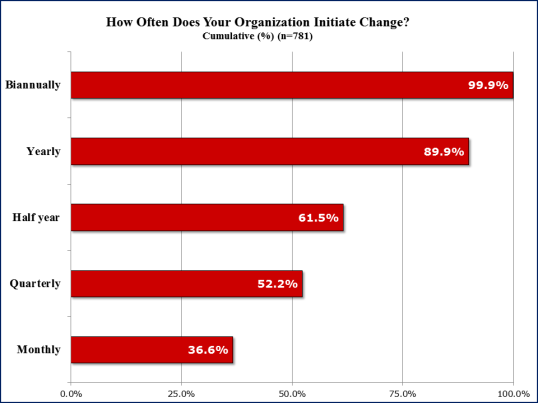How Well is Your ‘What’ Connected to Your ‘Why’?
We take an in-depth look at how our contributors improve their chances of thriving, by communicating in ways that build trust and engage people. For these contributors, communication must constantly focus on the Why of Change & What is Expected and what the change is not about. This is the Change Expectations Framework. It engages deeper understanding and helps everyone manage stress more effectively. Note: You may think everyone does these three steps, you are probably wrong at least 70% of the time according to studies over the last 10 years. Here’s why it is even more important today. Most contributors (89%) say that their organizations change at least every 12 months. These changes are driven by 3-4 simultaneous reasons for change . All these changes should have three things in common. What you expect people to:
- Stop doing (so that they can start doing new things)
- Start doing
- Continue doing
 Yet, this survey’s findings show that contributors rarely mention all three in the same contribution. Why is this important? It creates increased stress and potentially change resistance. It works like this. Assuming we are always managing change with limited resources like people, money, technology and time, leaders have to manage the tension between these three elements of stop, start and continue. Then, after deciding the commercial need for change, leaders need the Emotional Intelligence to identify which groups and individuals are likely to experience unhealthy stress and resistance. This underscores the need for leadership consensus on why are we changing. For many contributors, leader inconsistency fuels people’s natural resistance . The ever-increasing rate of change demands that leaders give clear and compelling reasons for employees to overcome their feelings of here we go again . Unfortunately, we conclude that too many leaders either ignore, or are unaware that change will be stressful for their peers and employees. Contributors readily see the need for change to adapt, survive or improve. The world’s ever-increasing pace demands that leaders give clear and compelling reasons for employees to overcome their feelings of here we go again. That response begs the question: What can leaders do about this condition. What follows are some thoughts. All those implementing change know in advance, to some extent, that a change will be stressful and that not everyone will be willing to engage. For example, people often work well under certain stress to increase productivity. But, under other circumstances, they are surprised at the stress that another aspect of change can induce. So, stress can be negative, positive or neutral. For example, passing in an examination can be just stressful as failing. The problem occurs when people are under excessive or prolonged stress – Unhealthy Stress. The challenge for change leaders is that stress is unique and personal. A situation may be stressful for someone, but the same situation may be challenging for others.
Yet, this survey’s findings show that contributors rarely mention all three in the same contribution. Why is this important? It creates increased stress and potentially change resistance. It works like this. Assuming we are always managing change with limited resources like people, money, technology and time, leaders have to manage the tension between these three elements of stop, start and continue. Then, after deciding the commercial need for change, leaders need the Emotional Intelligence to identify which groups and individuals are likely to experience unhealthy stress and resistance. This underscores the need for leadership consensus on why are we changing. For many contributors, leader inconsistency fuels people’s natural resistance . The ever-increasing rate of change demands that leaders give clear and compelling reasons for employees to overcome their feelings of here we go again . Unfortunately, we conclude that too many leaders either ignore, or are unaware that change will be stressful for their peers and employees. Contributors readily see the need for change to adapt, survive or improve. The world’s ever-increasing pace demands that leaders give clear and compelling reasons for employees to overcome their feelings of here we go again. That response begs the question: What can leaders do about this condition. What follows are some thoughts. All those implementing change know in advance, to some extent, that a change will be stressful and that not everyone will be willing to engage. For example, people often work well under certain stress to increase productivity. But, under other circumstances, they are surprised at the stress that another aspect of change can induce. So, stress can be negative, positive or neutral. For example, passing in an examination can be just stressful as failing. The problem occurs when people are under excessive or prolonged stress – Unhealthy Stress. The challenge for change leaders is that stress is unique and personal. A situation may be stressful for someone, but the same situation may be challenging for others.
Action Points: Reducing Employees Stress to Manage Change Resistance
Most contributor responses indicate that their organizations change anywhere from daily to annually. These changes are often unique to the organization, the triggers for change, and how change is managed. Yet all change has three things in common. The Three Common Elements of All Change Defining your own change and how it is managed starts with the following:
- Identifying what you expect people to stop doing, so that they can start doing new things
- Specifying what you expect people to start doing
- Confirming what you want people to continue doing, while continuing to coordinate and keep the organization running.
Focus on communicating constantly the why of change and what is expected for your change to be effective and communicate what the change is not about. This is the change expectations framework, which engages deeper understanding and helps everyone manage stress more effectively. To order Focusing Change To Win please click  To contact Nick nanderson@thecrispianadvantage.com or call 1+ (616) 745-8667
To contact Nick nanderson@thecrispianadvantage.com or call 1+ (616) 745-8667
